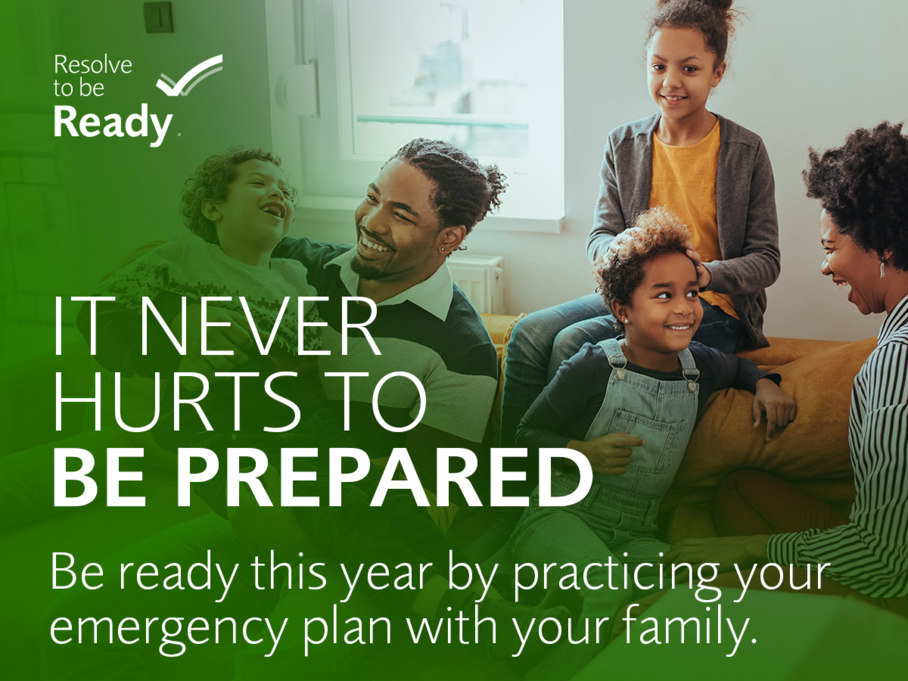This year, be prepared for whatever comes your way. These practical emergency preparedness tips will help you troubleshoot tricky situations before they happen. So when a problem arises, you and your family will already have a plan, and some peace of mind.
Planning Ahead
- Make an emergency plan: choose a safe place to meet, learn evacuation routes, and establish an out-of-town contact.
- Get to know your neighbor and invite them to be a part of your emergency plan.
- Take a first aid and CPR class. www.ready.gov/safety-skills
- Keep and update emergency supplies.
- Check your insurance for coverage on disasters like floods, hurricanes, and earthquakes.
Personal Finances
- Only 48% of people have an emergency fund, so build up your savings. Put a small amount in your account the first of every month beginning January 1. These funds can help you get life saving items like food, shelter, and water in an emergency. Saving tips: www.ready.gov/financial-preparedness
- Spend within your means. Use a personal budgeting worksheet to help plan for holiday expenses and beyond. Find out how with the Emergency Financial First Aid Kit.
- Include cash in your emergency supply kit. During an extended power outage, ATMs and credit card machines may not work.
Be Tech Ready
- Sign up to receive text or email alerts about emergencies from your local Office of Emergency Management.
- Download the FEMA app to get real-time alerts, safety tips, and locate open shelters.
- Snap photos of your property for insurance purposes. Also take photos of important documents and save them online or in a secure place you can access during an emergency.
- Set up group text lists so you can communicate with friends and family at the same time during emergencies.
- Download home budgeting apps to help you save for a rainy day.
- Have external back-up power sources available to charge phones and other devices in case of a power outage.
Preparedness Tips
- Preparing your family for an emergency is as simple as having a conversation over dinner. Make a plan tonight.
- Check-in with neighbors to see how you can help each other out before and after a storm.
- Pick an out-of-town person for everyone to contact during an emergency.
- Make a list of the things you would need or want to take with you if you had to leave your home quickly. Get prepared by having an emergency supply kit already stored. www.ready.gov/kit
- As part of your family’s emergency supply kit, include games and toys to keep children entertained.
- 30: The number of days it takes for flood insurance to begin. The time to buy is when it’s dry.
- If you rely on public transportation, contact your local emergency management agency about evacuation procedures before a hurricane.
- Prepare your car for winter: keep your gas tank near full to help avoid ice in the tank and fuel lines.
- Make a plan to check on neighbors if extreme cold or winter weather knocks out your power.
- Learn how to shut off the utilities where you live, including water, electricity, and gas.
- Assemble supplies for a “go-bag” you can carry if you need to evacuate www.ready.gov/evacuation
- Make a portable emergency kit for your car www.ready.gov/car
- Plan how you will leave and where you will go if you are advised to evacuate. Don’t forget to include pets in your plans! www.ready.gov/evacuation
Planning with Pets
- Take a current photo of you and your pet together in case you get separated during a disaster.
- Search online today for local pet-friendly evacuation locations in case you need to evacuate.
- Update your pet’s microchip registration info so you can be contacted if your pet gets lost in a disaster. www.ready.gov/pets
- Put your name and contact information on your pet’s ID tag in case you’re separated in an emergency. www.ready.gov/pets
It never hurts to be prepared.
Be Sure your family is ready for an emergency by having a conversation over dinner and making a plan tonight. For more practical tips to keep your family safe, visit www.ready.gov.








